Start an exciting journey through Seoul, the lively capital of South Korea. I’ll show you the top 10 things to do in Seoul. You’ll see ancient royal palaces and dive into K-pop culture. This guide will explore the city’s history, traditions, and modern charm.
Whether you’re here for a quick trip or a longer stay, Seoul has lots to offer. Get ready to experience the city’s unique blend of old and new.

“Gyeongbokgung Palace in Seoul during cherry blossom season, traditional Korean architecture with vibrant colors, royal guards in traditional attire, serene pond reflecting the palace, lush greenery surrounding the courtyard, clear blue sky, soft pink petals falling gently”
Exploring the Majestic Gyeongbokgung Palace Complex
Visiting Seoul’s Gyeongbokgung Palace is a must for those wanting to dive into Korea’s traditional and cultural heritage. It’s the largest palace from the Joseon Dynasty and gives a peek into Korea’s royal history.
Best Times to Visit the Palace
Morning is the ideal time to visit Gyeongbokgung. The grounds are quieter, and the lighting is beautiful. Make sure to catch the royal guard ceremony at 10 am and 2 pm for an unforgettable cultural experience.
Also Read:- Best Time To Visit Japan In 2025
Traditional Guard Changing Ceremony
The guard change is a show of precision and discipline. It’s a highlight for many, showing the Koreanroyal guards’ skill. It’s a glimpse into the Joseon Dynasty‘s military traditions.
National Folk Museum Highlights
- Explore the museum’s extensive collection of artifacts and exhibits showcasing Korean history and culture.
- Learn about traditional Korean homes, called hanoks, and their unique architecture.
- Explore traditional crafts like pottery, metalwork, and textiles that have been passed down for generations.
Gyeongbokgung Palace and the National Folk Museum offer a deep look into Korea’s rich cultural heritage and the Joseon Dynasty‘s traditions. A visit here is key to any cultural experience in Seoul.
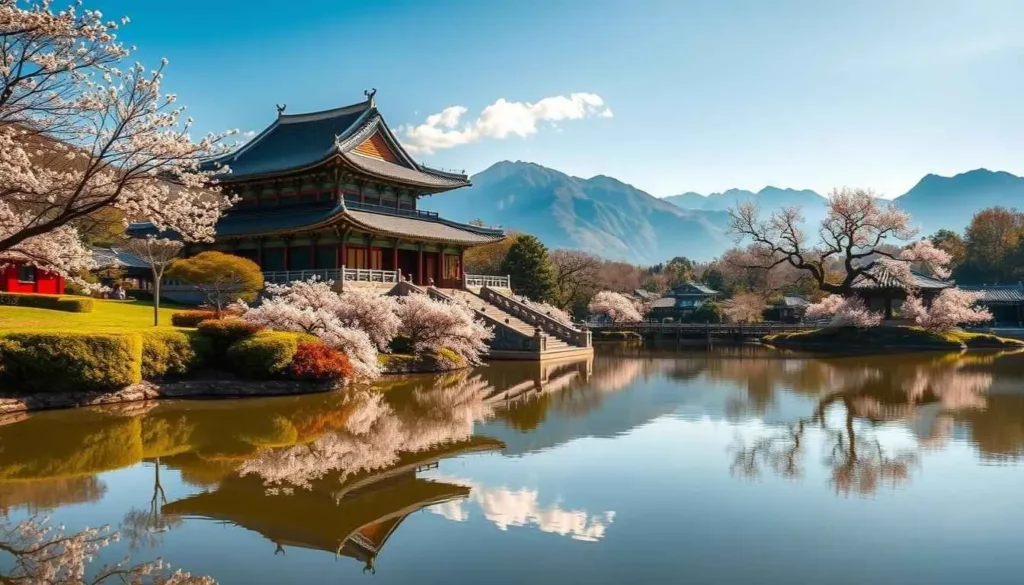
Gyeongbokgung Palace in Seoul, South Korea, showcasing traditional Korean architecture with vibrant colors, surrounded by lush gardens and serene ponds, majestic mountains in the background, cherry blossom trees in full bloom, reflecting on tranquil water surfaces, warm sunlight casting gentle shadows.
Things to Do in Korea: Discovering Seoul’s Traditional Markets
Seoul’s traditional markets burst with vibrant sights, sounds, and flavors, embodying the essence of Korean culture. Namdaemun Market and Gwangjang Market stand out as prime destinations for authentic Korean street food and shopping experiences.
Namdaemun Market, Seoul’s biggest traditional market, is full of life. You’ll find everything from hanbok fabrics to handmade crafts. Don’t miss the smell of Korean street food like tteokbokki and odeng.
- See a wide range of traditional Korean souvenirs and local treats.
- Try your hand at haggling with vendors for a fun shopping trip.
- Try dishes that have been loved for generations.
Don’t miss Gwangjang Market for more traditional Korean food and energy. It’s a place where you can see vendors showing off their homemade foods.
- Try Korean favorites like bindaetteok and kimchi mandu.
- See the skill of traditional Korean crafts and textiles.
- Feel the lively vibe and talk with locals to get the real feel of Seoul.
Looking for real flavors, energy, or unique gifts? Seoul’s markets are a journey into Korean culture and tradition. It’s an adventure you won’t forget.
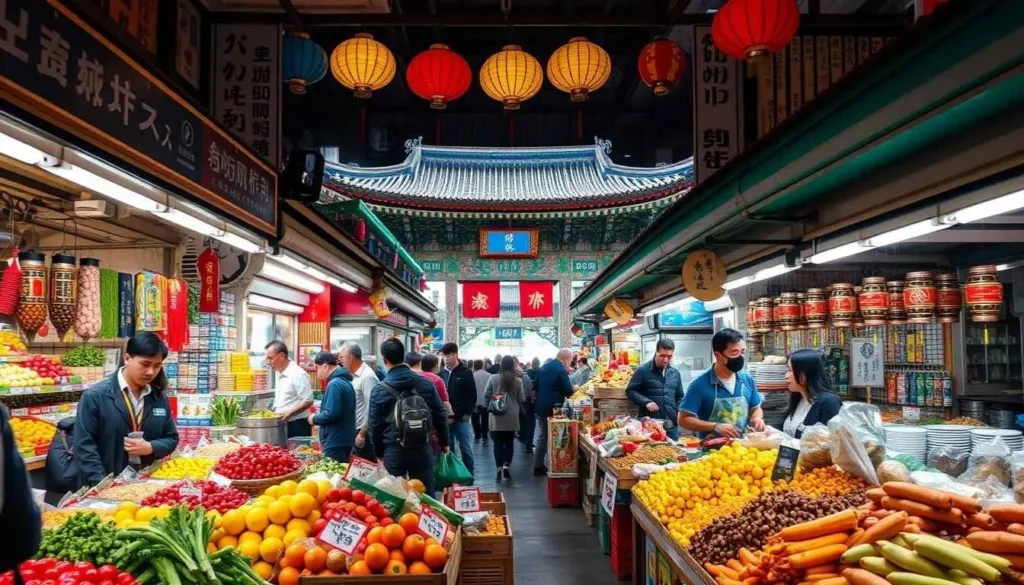
A vibrant scene of Namdaemun Market in Seoul, bustling with activity, showcasing colorful stalls filled with fresh produce, street food vendors preparing traditional Korean dishes, shoppers exploring the market, the iconic Namdaemun Gate in the background, lanterns hanging overhead, and the rich textures and colors of fruits, vegetables, and spices filling the air with a lively atmosphere.
Immersing in Bukchon Hanok Village’s Cultural Heritage
Step back in time at Bukchon Hanok Village. This historic neighborhood in Seoul shows the traditional Korean way of life. You can see traditional Koreans houses up close.
Traditional Korean Tea Houses Experience
Try fragrant Korean tea in historic tea houses in Bukchon Hanok Village. These cozy spots offer a real cultural experience. You can enjoy tea drinking and learn about Korea’s tea culture.
Photography Spots in Hanok Village
Bukchon Hanok Village is perfect for photographers. It has many chances to capture traditional Korean architecture. Explore narrow alleys, find hidden courtyards, and take photos of iconic rooftops against the city skyline.
Cultural Workshops and Activities
- Join traditional Korean cultural workshops like calligraphy, pottery, or Korean fan painting. Learn techniques passed down through generations.
- Learn about Bukchon Hanok Village’s heritage through hands-on demonstrations. Try making hanbok or hanji art.
- Go on a guided tour to learn more about this cultural heritage site. Understand the traditions that shape Korean identity.
Bukchon Hanok Village is a captivating place. It lets you explore traditional Korean houses and the rich culture of this neighborhood.
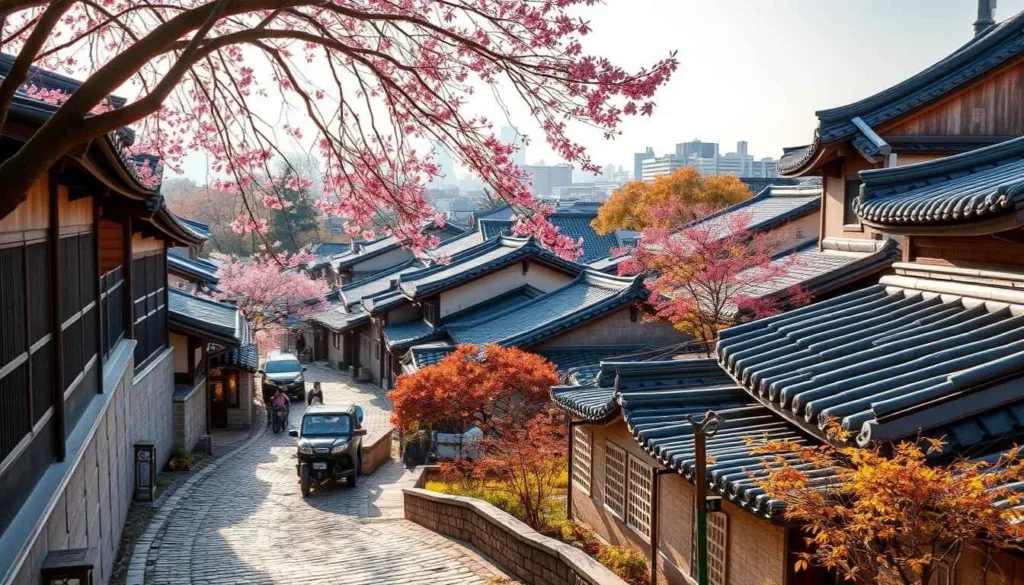
A serene view of Bukchon Hanok Village in Seoul, showcasing traditional Korean hanok houses with their distinctive curved roofs, surrounded by vibrant seasons of cherry blossoms or autumn leaves, cobblestone paths winding through the village, and the backdrop of modern Seoul skyline blending with historical architecture, soft sunlight illuminating the scene.
Ascending N Seoul Tower for Panoramic City Views
The N Seoul Tower sits atop Namsan Mountain, giving visitors a stunning view of Seoul. It’s a top spot in the city, perfect for those wanting to see Korea’s lively capital.
Reaching the top by cable car, you get to see the city in all directions. The Seoul skyline stretches out, with buildings and parks creating a beautiful scene.
The N Seoul Tower is more than just views. It’s also home to the famous love locks. Couples attach padlocks to the tower to show their love. This tradition is loved by both locals and visitors.
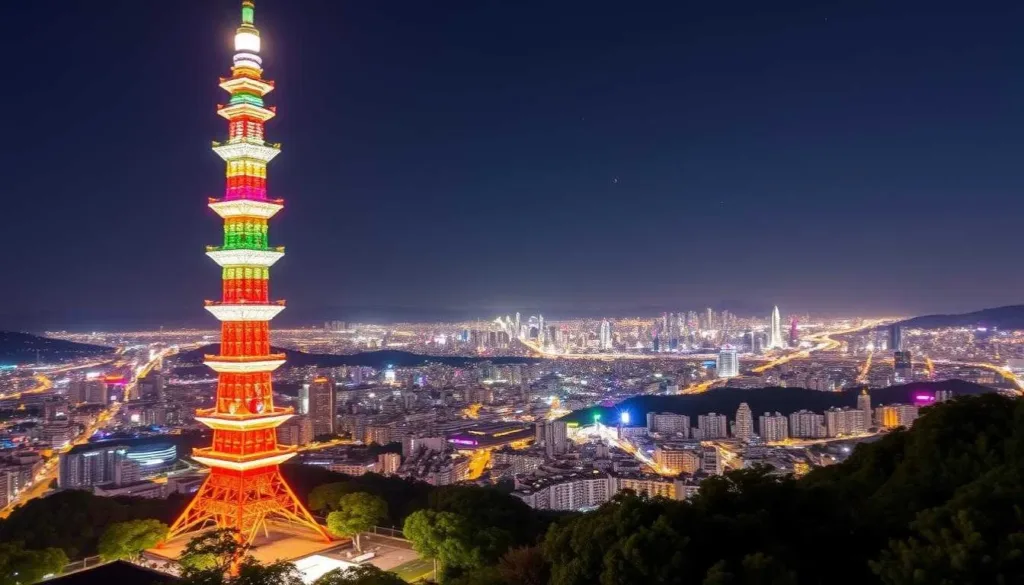
“N Seoul Tower glowing at night, amidst a lively cityscape with a sweeping view of Seoul’s skyline. Lush greenery frames the scene, while gentle lights cast a radiant glow on the tower. A clear, starry sky stretches above, completing the picturesque view.”
For an optimal experience, visit during the golden hour. As the sun sets, the city bathes in a warm glow. The serene mountains enhance the beauty of Seoul.
- Savor the panoramic views of the Seoul skyline from the observation deck
- Ride the iconic cable car up the mountain for a unique perspective
- Participate in the romantic tradition of attaching love locks to the tower’s fences
- Explore the various attractions and eateries within the N Seoul Tower complex
- Time your visit during the golden hour for the most breathtaking experience
The breathtaking view from N Seoul Tower offers the perfect vantage point to admire the beauty and vibrancy of this incredible city.
Experiencing Temple Stay at Jogyesa Temple
Exploring Korean Buddhist culture is a deep experience. A temple stay at Jogyesa Temple in Seoul is perfect for this. This historic temple, in the city’s heart, lets visitors join Buddhist ceremonies, meditate, and try traditional temple food.
Buddhist Ceremonies and Meditation Sessions
At your temple stay, you’ll see and join Buddhist ceremonies. You’ll hear chanting and see candles lit. These moments show Korean Buddhism’s spiritual depth. You’ll also meditate, learning to calm your mind in the city’s noise.
Traditional Temple Cuisine
Savor the sensory delight of Jogyesa Temple’s cuisine. Indulge in authentic temple dishes crafted from fresh, seasonal ingredients. Each meal, from hearty vegetable stews to fragrant rice, nurtures both body and spirit.
Morning Chanting Rituals
Wake up early for Jogyesa Temple’s morning chanting. As dawn breaks, monks’ voices fill the air. This peaceful moment grounds you, preparing you for a day exploring Korean Buddhist culture.
A temple stay at Jogyesa Temple is a rare chance to dive into Korean Buddhism. It’s perfect for those seeking spiritual growth, cultural insight, or a quiet moment in the city. This experience will deeply impact your visit to Seoul.
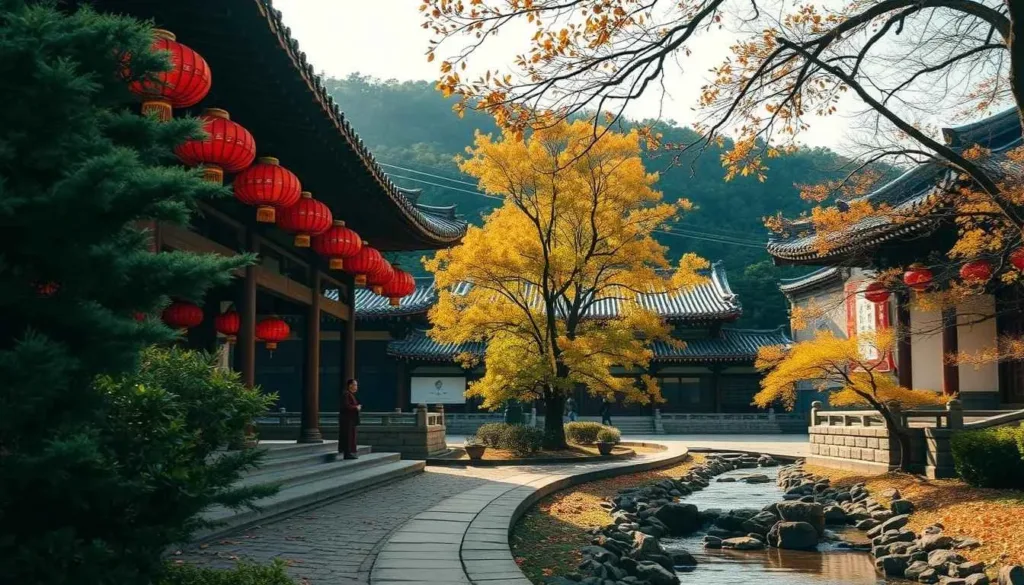
Serene scene of Jogyesa Temple in Seoul, showcasing vibrant lanterns hanging from the eaves, traditional Korean architecture with intricate details, lush greenery surrounding the temple grounds, peaceful monks walking in meditation, a gentle stream flowing nearby, golden autumn leaves falling, soft sunlight filtering through trees, tranquil atmosphere, and rich cultural textures.
Shopping and K-Pop Culture in Gangnam District
Gangnam District is the heart of high-end shopping and K-pop culture in Seoul, South Korea. It’s a place where fashion and entertainment meet. Here, you’ll find luxury retail, trendy cafes, and K-pop experiences like no other.
The COEX Mall is a must-see in Gangnam. It’s a huge underground mall with an aquarium, movie theaters, and lots of shops and places to eat. You can find designer boutiques and Korean beauty product stores here. Nearby, K-Star Road celebrates Korean pop culture. You can take photos with K-pop star statues and visit themed cafes.
Gangnam is also known for its cafe culture. You can enjoy specialty coffee and desserts at trendy cafes. These cafes offer a south Korea travel. For a real K-pop experience, check out a K-pop-themed cafe.
| Top Shopping Destinations in Gangnam | K-Pop Culture Attractions |
|---|---|
| COEX Mall | K-Star Road |
| Luxury Boutiques | K-Pop Themed Cafes |
| Korean Beauty Product Stores | K-Pop Star Statues |
Gangnam District is the best place for shopping, beauty trends, and K-pop culture in Seoul. It offers an unforgettable experience.
Exploring the Trendy Streets of Hongdae
Hongdae, Seoul’s vibrant university district, buzzes with creativity and youth culture. This area blends street performances, distinctive cafes, and night markets, making it a prime destination for anyone eager to experience Seoul’s artistic energy and lively nightlife.
Street Performance Hotspots
Walking through Hongdae, you’ll see street performers showing off their skills. Musicians, dancers, acrobats, and magicians fill the streets. It’s a chance to see talented artists up close and enjoy the lively atmosphere.
Unique Cafe Culture
Hongdae’s cafe scene shows off the area’s creative side. You’ll find cafes with themes like retro and artsy latte art. Enjoy special drinks in cozy, photo-worthy spots that locals and visitors love.
Night Market Adventures
At night, Hongdae turns into a lively night market. Vendors sell street food, handmade crafts, and unique souvenirs. It’s a chance to try local foods and feel the district’s youthful energy.
Hongdae captures the vibrant spirit of Seoul’s youth culture. The lively street performances, cozy cafes, and bustling night markets create an unforgettable atmosphere.
Taking a DMZ Tour from Seoul
Visiting the Demilitarized Zone (DMZ) between North and South Korea is a unique opportunity to learn about the complex history and current situation of the Korean Peninsula. The DMZ is the world’s most heavily guarded border. It provides a sobering view of the Korean War’s lasting effects and the ongoing tensions between the two countries.
On a typical DMZ tour from Seoul, you’ll explore key sites along the border. You’ll see the iconic Panmunjom, where the armistice agreement ending the Korean War was signed. You’ll also get to peer into North Korea travel through the blue buildings of the Joint Security Area, a surreal and thought-provoking experience.
Another must-see on a DMZ tour is the Third Tunnel. It’s one of several secret tunnels discovered over the years that were intended for a surprise attack on the South. Descending into this underground passageway gives a glimpse into the military history and strategic importance of the border region.
| DMZ Tour Highlights | What to Expect |
|---|---|
| Panmunjom | Tour the Joint Security Area and view North Korea from the famous blue buildings where the armistice agreement was signed. |
| Third Tunnel | Explore the underground tunnel system, a testament to the ongoing military tensions and the Korean War history. |
| DMZ Tour | Gain a deeper understanding of the division of the Korean Peninsula and the North Korea regime through this unique experience. |
Booking a DMZ tour from Seoul is easy. Many tour operators offer different options to fit various interests and budgets. Whether you’re interested in the Panmunjom Joint Security Area or the captivating Third Tunnel, a DMZ tour is a must. It’s a chance to witness the legacy of the Korean Warand the ongoing geopolitical dynamics on the Korean Peninsula.
Strolling Along Cheonggyecheon Stream
In the heart of Seoul, the Cheonggyecheon stream is a beautiful oasis. It shows the city’s amazing urban renewal. Once ignored, it’s now a favorite spot for peace away from the city’s noise.
Seasonal Festivals and Light Shows
The Cheonggyecheon stream hosts many Seoul festivals and light shows all year. The Spring Flower Festival fills the banks with colors. The Lantern Festival lights up the night with magical lights.
Historical Significance and Restoration
The Cheonggyecheon stream is very important in Seoul’s history. In the mid-2000s, the city started a big urban renewal project. They uncovered the stream and made it a peaceful place that honors Seoul’s past.
Popular Photo Locations
The Cheonggyecheon stream is a top spot for night photography and finding romantic spots in Seoul. Its bridges and city reflections make for amazing photos.
Looking for peace, culture, or a beautiful spot for photos? The Cheonggyecheon stream is a must-see. It shows Seoul’s beauty and change.
Discovering Korean Cuisine in Myeongdong
Myeongdong, the vibrant core of Seoul, is a paradise for food enthusiasts. The bustling streets are alive with the enticing aromas of Korean street food. The air is filled with the scent of sizzling tteokbokki and warm, fluffy hotteok. This district is an entryway into Korea’s rich culinary heritage.
For a true taste of Korea, try a famous restaurant in Myeongdong. Tosokchon Samgyeopsal serves amazing pork belly with kimchi and banchan. Myeongdong Kyoja is known for its kalguksu and mandu.
Want to learn Korean cooking? Myeongdong has cooking schools for that. I can learn to make kimchi, bibimbap, and bulgogi. These classes teach me cooking skills and the stories behind the dishes.



